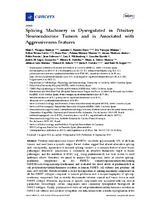Mostrar el registro sencillo del ítem
Splicing Machinery is Dysregulated in Pituitary Neuroendocrine Tumors and is Associated with Aggressiveness Features
| dc.contributor.author | Vázquez Borrego, María del Carmen | |
| dc.contributor.author | Fuentes-Fayos, Antonio C. | |
| dc.contributor.author | Venegas-Moreno, Eva | |
| dc.contributor.author | Rivero-Cortés, Esther | |
| dc.contributor.author | Dios, Elena | |
| dc.contributor.author | Moreno Moreno, Paloma | |
| dc.contributor.author | Madrazo-Atutxa, Ainara | |
| dc.contributor.author | Remón, Pablo | |
| dc.contributor.author | Solivera, Juan | |
| dc.contributor.author | Wildemberg, Luiz E. | |
| dc.contributor.author | Kasuki, Leandro | |
| dc.contributor.author | López-Fernández, Judith M. | |
| dc.contributor.author | Gadelha, Mônica R. | |
| dc.contributor.author | Gálvez-Moreno, M. Ángeles | |
| dc.contributor.author | Soto-Moreno, Alfonso | |
| dc.contributor.author | Gahete Ortiz, Manuel D. | |
| dc.contributor.author | Castaño, Justo P. | |
| dc.contributor.author | Luque, Raúl M. | |
| dc.date.accessioned | 2019-09-27T11:51:37Z | |
| dc.date.available | 2019-09-27T11:51:37Z | |
| dc.date.issued | 2019 | |
| dc.identifier.uri | http://hdl.handle.net/10396/19009 | |
| dc.description.abstract | Pituitary neuroendocrine tumors (PitNETs) constitute approximately 15% of all brain tumors, and most have a sporadic origin. Recent studies suggest that altered alternative splicing and, consequently, appearance of aberrant splicing variants, is a common feature of most tumor pathologies. Moreover, spliceosome is considered an attractive therapeutic target in tumor pathologies, and the inhibition of SF3B1 (e.g., using pladienolide-B) has been shown to exert antitumor effects. Therefore, we aimed to analyze the expression levels of selected splicing-machinery components in 261 PitNETs (somatotropinomas/non-functioning PitNETS/corticotropinomas/prolactinomas) and evaluated the direct effects of pladienolide-B in cell proliferation/viability/hormone secretion in human PitNETs cell cultures and pituitary cell lines (AtT-20/GH3). Results revealed a severe dysregulation of splicing-machinery components in all the PitNET subtypes compared to normal pituitaries and a unique fingerprint of splicing-machinery components that accurately discriminate between normal and tumor tissue in each PitNET subtype. Moreover, expression of specific components was associated with key clinical parameters. Interestingly, certain components were commonly dysregulated throughout all PitNET subtypes. Finally, pladienolide-B reduced cell proliferation/viability/hormone secretion in PitNET cell cultures and cell lines. Altogether, our data demonstrate a drastic dysregulation of the splicing-machinery in PitNETs that might be associated to their tumorigenesis, paving the way to explore the use of specific splicing-machinery components as novel diagnostic/prognostic and therapeutic targets in PitNETs. | es_ES |
| dc.format.mimetype | application/pdf | es_ES |
| dc.language.iso | eng | es_ES |
| dc.publisher | MDPI | es_ES |
| dc.rights | https://creativecommons.org/licenses/by/4.0/ | es_ES |
| dc.source | Cancers 11(10), 1439 (2019) | es_ES |
| dc.subject | Splicing | es_ES |
| dc.subject | Spliceosome | es_ES |
| dc.subject | Pituitary neuroendocrine tumors | es_ES |
| dc.subject | Pladienolide-B | es_ES |
| dc.title | Splicing Machinery is Dysregulated in Pituitary Neuroendocrine Tumors and is Associated with Aggressiveness Features | es_ES |
| dc.type | info:eu-repo/semantics/article | es_ES |
| dc.relation.publisherversion | http://dx.doi.org/10.3390/cancers11101439 | es_ES |
| dc.relation.projectID | Junta de Andalucía. CTS-1406 | es_ES |
| dc.relation.projectID | Junta de Andalucía. BIO-0139 | es_ES |
| dc.relation.projectID | Gobierno de España. BFU2016-80360-R | es_ES |
| dc.relation.projectID | Instituto de Salud Carlos III. PI16/00264 | es_ES |
| dc.relation.projectID | Instituto de Salud Carlos III. CIBEROBN | es_ES |
| dc.rights.accessRights | info:eu-repo/semantics/openAccess | es_ES |

